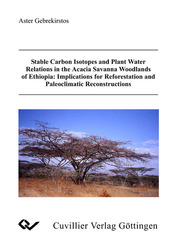| Fachbereiche | |
|---|---|
| Buchreihen (96) |
1378
|
| Nachhaltigkeit |
3
|
| Gesundheitswesen |
1
|
| Geisteswissenschaften |
2365
|
| Naturwissenschaften |
5406
|
| Mathematik | 229 |
| Informatik | 319 |
| Physik | 980 |
| Chemie | 1363 |
| Geowissenschaften | 131 |
| Humanmedizin | 243 |
| Zahn-, Mund- und Kieferheilkunde | 10 |
| Veterinärmedizin | 108 |
| Pharmazie | 147 |
| Biologie | 835 |
| Biochemie, Molekularbiologie, Gentechnologie | 121 |
| Biophysik | 25 |
| Ernährungs- und Haushaltswissenschaften | 45 |
| Land- und Agrarwissenschaften | 1004 |
| Forstwissenschaften | 201 |
| Gartenbauwissenschaft | 20 |
| Umweltforschung, Ökologie und Landespflege | 148 |
| Ingenieurwissenschaften |
1793
|
| Allgemein |
98
|
|
Leitlinien Unfallchirurgie
5. Auflage bestellen |
|
Erweiterte Suche
Stable Carbon Isotopes and Plant Water Relations in the Acacia Savanna Woodlands of Ethiopia: Implications for Reforestation and Paleoclimatic Reconstructions
Aster Gebrekistos (Autor)Vorschau
Inhaltsverzeichnis, Datei (42 KB)
Leseprobe, Datei (82 KB)
The savanna woodlands, which were estimated to cover 30% of the total land area of Ethiopia, are inhabited by economically, environmentally and socially valuable plant and animal species. However, vast areas of the savanna type vegetation are being destroyed due to anthropogenic interferences. Restoration/reforestation of large areas of degraded lands is a major challenge faced in Ethiopia today. Lack of knowledge, on site – species matching (exotic species), led to failure of most of the attempted reforestation programs and lack of information on the ecology and ecophysiology of indigenous species limited their use in reforestation projects. Despite prevailing harsh environmental conditions, naturally occurring tree and shrub species in the savannas have survived with the help of adaptive traits, which they have acquired due to long term exposure to ecological stress. Therefore, this study was carried out to find the answers for the following questions: i) could these adaptive traits be identified and manipulated to provide a basis for selecting important tree species suitable for rehabilitation/reforestation of degraded lands? ii) Do some of these species compete favourably for scarce resources and grow well in mixed communities? iii) To what extent does land degradation as a result of natural or anthropogenic interferences disrupt ecophysiological stability and lead to poor adaptations? and iv) What are the climate-growth relationships in the savanna woodlands?.
| ISBN-13 (Printausgabe) | 3865377645 |
| ISBN-13 (Printausgabe) | 9783865377647 |
| ISBN-13 (E-Book) | 9783736917644 |
| Sprache | Englisch |
| Seitenanzahl | 156 |
| Auflage | 1 |
| Band | 0 |
| Erscheinungsort | Göttingen |
| Promotionsort | Göttingen |
| Erscheinungsdatum | 19.02.2006 |
| Allgemeine Einordnung | Dissertation |
| Fachbereiche |
Umweltforschung, Ökologie und Landespflege
|








